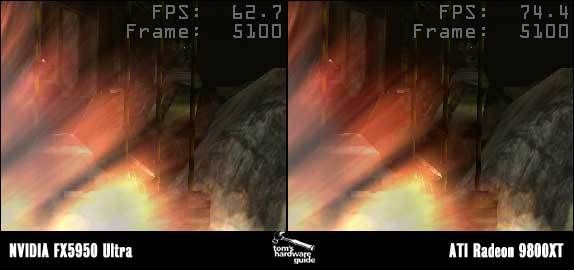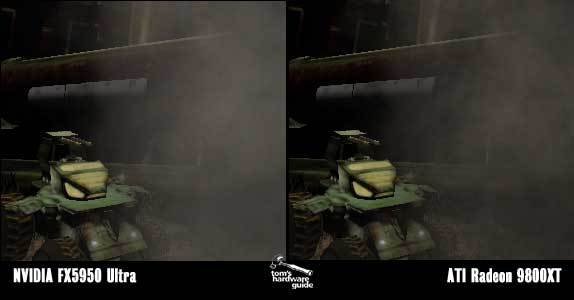NVIDIA Puts Its (New) Cards on the Table
AquaMark 3 - Massive Overdraw
The "Massive Overdraw" test in AquaMark 3 aims to test the limits of a graphics card's fillrate. In the explosion pictured below, numerous layers of textures are added onto one another (Particle Effect) and then slowly faded out. It seems that ATi's driver doesn't continue to fade out the textures until the blending ends, instead simply cutting out certain textures when a certain degree of fade-out is reached. This obviously saves memory bandwidth, leading to a higher framerate. In the direct comparison with the image rendered by NVIDIA's FX 5950 Ultra, the result is a darker and less detailed explosion (Frame 5100).
Click for uncompressed PNG image!
The following animation should illustrate the difference (beware of load times!).
Click for uncompressed PNG image!
Since the express purpose of this test is to test a card's memory bandwidth, an optimization such as this seems more than a bit questionable and smacks of cheating - that is, if this behavior is the result of deliberate action on ATi's part and not a driver bug in the end. Other explosions in AquaMark 3 displayed the same early fade-out effect.
We also came across some other irregularities in conjunction with particle effects in AquaMark 3 (Frame 1050):
Click for uncompressed PNG image!
Get Tom's Hardware's best news and in-depth reviews, straight to your inbox.
The density of the smoke or refuse that is shown spewing from the pipe in this picture is much lower on the Radeon 9800 XT than on the FX 5950 Ultra. The vehicle at the left-hand edge of the screen proves that this is not the result of some difference in lighting or gamma settings.
Current page: AquaMark 3 - Massive Overdraw
Prev Page Pixel Shader Quality, Continued Next Page Unreal Tournament - Detail Textures - More "irregularities"?

